HIKING HAPPENINGS September 2010
Clark’s Lake – A Delightful Summer Sojourn
by Marcy Hafner
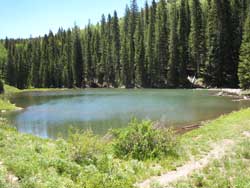 When this country was gripped by the Great Depression, Franklin D. Roosevelt, desperate to get men back to work, proposed the Civilian Conservation Corps (CCC) - a five year public relief program that provided three million jobs in unskilled manual labor for the conservation and development of natural resources in rural areas of the United States. In the spring of 1933, a CCC camp employing almost 200 men was established at the Warner Ranger Station. In one season the workers completed range improvements, overhauled trails and roads, dug lengthy water diversion ditches and rebuilt part of the La Sal Loop Road. They also constructed the stream-fed reservoirs of Medicine, Oowah and Clark and made improvements to Warner. These projects, especially our beautiful alpine lakes, have now become an integral part of the La Sal Mountains. It’s hard to imagine all the strenuous work that went into their construction and even harder to picture our landscape without them. When this country was gripped by the Great Depression, Franklin D. Roosevelt, desperate to get men back to work, proposed the Civilian Conservation Corps (CCC) - a five year public relief program that provided three million jobs in unskilled manual labor for the conservation and development of natural resources in rural areas of the United States. In the spring of 1933, a CCC camp employing almost 200 men was established at the Warner Ranger Station. In one season the workers completed range improvements, overhauled trails and roads, dug lengthy water diversion ditches and rebuilt part of the La Sal Loop Road. They also constructed the stream-fed reservoirs of Medicine, Oowah and Clark and made improvements to Warner. These projects, especially our beautiful alpine lakes, have now become an integral part of the La Sal Mountains. It’s hard to imagine all the strenuous work that went into their construction and even harder to picture our landscape without them.
Clark’s Lake is only accessible by a non-motorized trail and that isolation offers more opportunities for a peaceful lakeside experience than can be found at the other more popular drive-in lakes. The Clark’s Lake Trail, which starts at Oowah Lake, is a pleasurable 1.2-mile lake-to-lake pathway that guides you to its quiet waters. The sign for the trail is immediately adjacent to the billboard next to the parking lot. The other trail that skirts the south side of Oowah goes to Boren Mesa and on to the Geyser Pass Road. It is also possible to make a long loop from this trail, via Clark’s Lake, back to the parking lot.
To get to Oowah Lake from Moab, go south on Highway 191 approximately 7.5 miles. Then turn left at the sign for the Ken’s Lake-La Sal Loop Road, continue half a mile to the stop sign at the tee and turn right on to the Spanish Valley Drive-La Sal Loop Road. From here it is 11.4 miles up the steeply twisting route past the Pack Creek and Geyser Pass Roads to the turn for Oowah Lake, which is just before the bridge over Mill Creek. This narrow three-mile graded dirt road is fine for cars, but trailers and RVs are not advised on the tight switchbacks. At an elevation of 8,800 feet, Oowah Lake is a popular spot for fishing and camping. The charge for a campsite is $5.00 per night and a fishing license is required for anyone 12 years old or older.
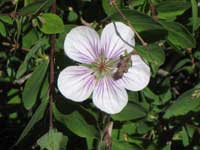 It is a steep grind up the first part of the trail so I don’t mind pausing to wonder at the antiquity and history of an abandoned well that has water gushing out of a pipe into the creek. Continuing upward on a warm day, I pass through a gate and shortly afterward a sharp switchback gains me some extra elevation. Stimulated by the heat, boisterous locusts crank up their whiny tune to full throttle. I am grateful for the blessed shade of the quaking aspens, firs and spruce and breathing deeply, I savor the earthy fragrance of the pungent pine-scented air. It is a steep grind up the first part of the trail so I don’t mind pausing to wonder at the antiquity and history of an abandoned well that has water gushing out of a pipe into the creek. Continuing upward on a warm day, I pass through a gate and shortly afterward a sharp switchback gains me some extra elevation. Stimulated by the heat, boisterous locusts crank up their whiny tune to full throttle. I am grateful for the blessed shade of the quaking aspens, firs and spruce and breathing deeply, I savor the earthy fragrance of the pungent pine-scented air.
After the trail finally levels out, I weave my way in and out of a patchwork of fertile meadows that are filled with a delightful harvest of wildflowers. The painted lady butterflies languidly drift to and from larkspur, golden pea, cutleaf daisies, geraniums and lupines as they gluttonously sip up their sweet bounty of nectar. They can’t eat, but instead drink up nourishment through their straw-like spiral proboscis.
Probably the most widespread butterfly throughout Africa, Europe, Asia and North America, this cosmopolitan butterfly deserves the alternate name “Cosmopolite.” Every March and April these salmon-colored, black patterned beauties with the distinctive white spots on their outer wings stream out of northern Mexico to repopulate the west – in some memorable years they migrate in impressive swarms.
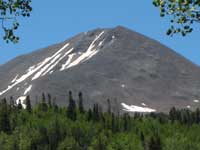 The two dominant peaks on the upper section of this trail are Haystack Mountain to the north and Mount Mellenthin to the south. The distinctive appearance of Haystack with its stark outline of stunted trees that extend almost 11,641-feet to the summit makes it easy to recognize. The two dominant peaks on the upper section of this trail are Haystack Mountain to the north and Mount Mellenthin to the south. The distinctive appearance of Haystack with its stark outline of stunted trees that extend almost 11,641-feet to the summit makes it easy to recognize.
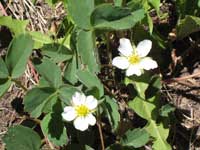 On this perfectly clear end of June day, a robin’s egg blue sky highlights the massive dome of Mount Mellenthin where remnant snowfields on the north face of this 12,645-foot peak linger on. The namesake for this impressive peak is Rudolph Mellenthin, who was born in Germany in 1884. At a young age, he immigrated to the United States with his family, and they gravitated to the West. On this perfectly clear end of June day, a robin’s egg blue sky highlights the massive dome of Mount Mellenthin where remnant snowfields on the north face of this 12,645-foot peak linger on. The namesake for this impressive peak is Rudolph Mellenthin, who was born in Germany in 1884. At a young age, he immigrated to the United States with his family, and they gravitated to the West.
On August 9, 1909, he accepted an assignment as a “forest guard” in the La Sal National Forest. Unfortunately, ranchers used to a free rein in the La Sal Mountains resented the intrusion of government restrictions. It didn’t take long before Mellenthin’s thick German accent and fanatical devotion to forest regulations had earned him the nickname “Kaiser.”
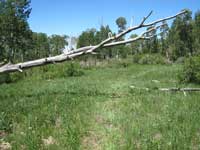 In July 1918, San Juan County sheriff Frank Barnes deputized Mellenthin to arrest Ramon Archuletta, an army deserter who had already escaped from two previous recaptures. Attempting to avoid detection, Archuleta traveled with his father-in-law, Ignacio Martinez, and another companion, Francesco Maestas, to a sheep camp on Pine Bluff, a few miles north of La Sal. In July 1918, San Juan County sheriff Frank Barnes deputized Mellenthin to arrest Ramon Archuletta, an army deserter who had already escaped from two previous recaptures. Attempting to avoid detection, Archuleta traveled with his father-in-law, Ignacio Martinez, and another companion, Francesco Maestas, to a sheep camp on Pine Bluff, a few miles north of La Sal.
Two of Mellenthin’s friends went with him to investigate the outlaw’s camp, but when ordered to hand his rifle over to his father-in-law, Archuleta instead began firing. Mortally wounded, Mellenthin still had the strength to draw and shoot, injuring Archuletta in his knee and hand. A posse arrived just a few minutes before he died, and in honor of that sacrifice, Mount Mellenthin will always be a memorial to him.
Passing through a big vegetated slope - a slanted garden crammed full of splashy colored flowers - I look down upon the picturesque emerald green waters of Clark’s Lake. Just before the gate, I leave the trail and head down to my goal for the day rather than continuing on to Moonlight Meadows and Geyser Pass.
I am so ready for this break, but as soon as I sit down, long-legged mosquitoes move in for the attack. A sudden welcome breeze that ripples the water and sways the tips of the trees, however, pushes them away, allowing me to stop swatting and instead relax and savor this refreshing lakeside scenery. Surrounded by pink clover, wild strawberries and dandelions I study a steep slope on the other side where aspens, firs, and spruce desperately cling to unsteady ground.
On an overly warm, sunny day, I relish a chill out at Clark’s Lake but I also like the fickleness and excitement of an approaching thunderstorm, which are more common during July and August. When that happens the lashing wind and ominous collection of dark billowing clouds cast an eerie, somber mood upon the lake. The mid-air fireworks are spectacular to watch against the darkened sky and sometimes the rain does start to fall; but chances are, the minute I dig out my raincoat, I won’t need it!!
With summer winding down, I look forward to that glorious season of fall, when aspens will be decked out in their brilliant autumn color of gold. Then a walk to Clark’s Lake is a sensational blaze of yellow. In the high country this happens in a hurry so be sure to get up there and enjoy the fall nostalgia before that two to three week window of fleeting golden splendor is gone.
|
Biological Soil Crust (aka)
Cryptos (krip’ tose):
The surface of
Moab’s desert is held
together by a thin skin of living organisms known as cryptobiotic
soil or cryptos. It has a lumpy black appearance, is very
fragile, and takes decades to heal when it has been damaged.
This soil is a critical part of the survival of the desert.
The cryptobiotic organisms help to stabilize the soil, hold
moisture, and provide protection for germination of the seeds
of other plants. Without it the dry areas of the west would
be much different. Although some disturbance is normal and
helps the soil to capture moisture, excessive disturbance
by hooves, bicycle tires and hiking boots has been shown
to destroy the cryptobiotic organisms and their contribution
to the soil. When you walk around Moab avoid crushing the
cryptos. Stay on trails, walk in washes, hop from stone to
stone. Whatever it takes, don’t crunch the cryptos
unless you absolutely have to! |
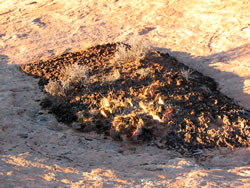
Cryptobiotic soil garden
|
|
|